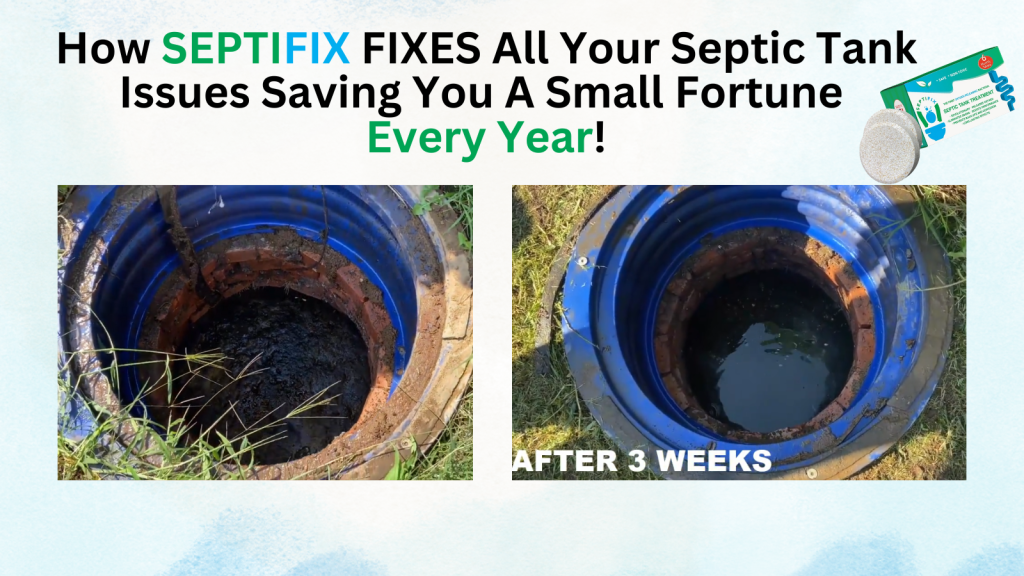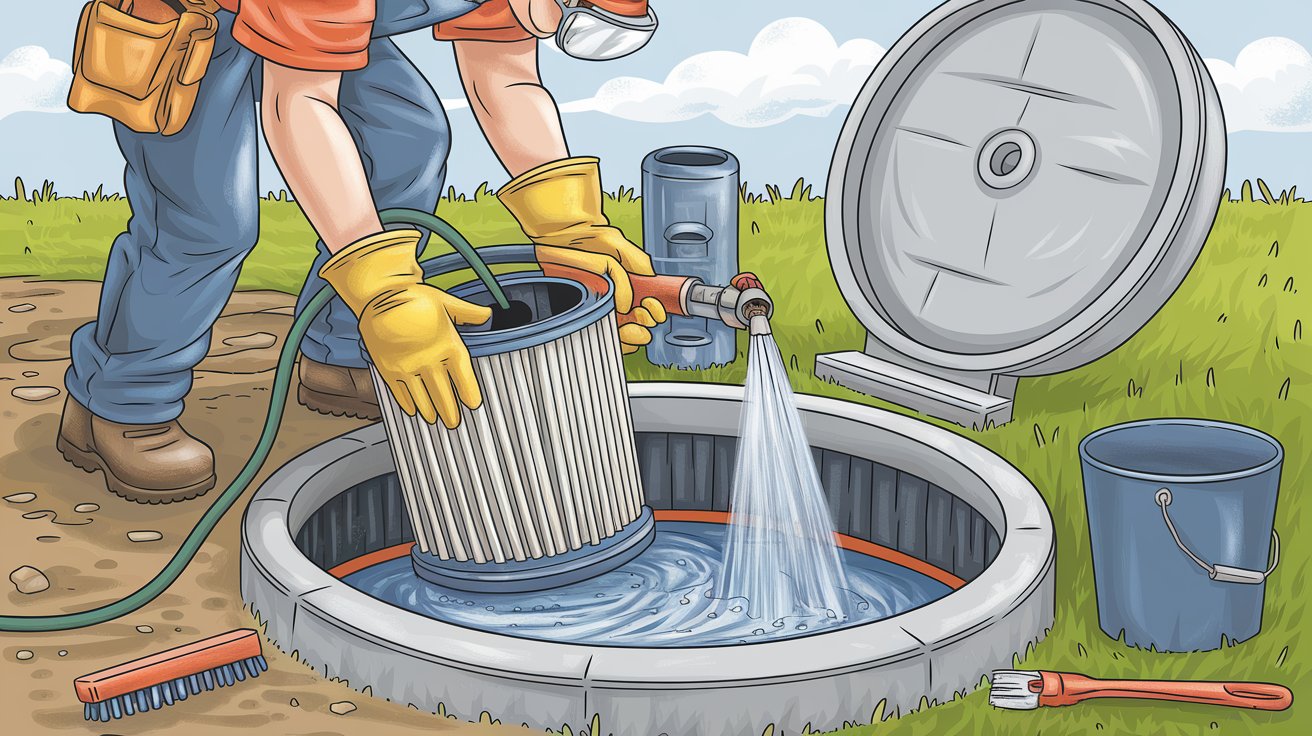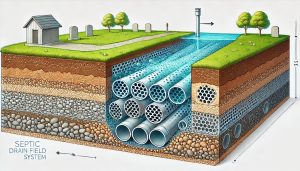Your septic filter plays a crucial role in preventing solids from entering the drain field, ensuring your septic system runs smoothly. Knowing how to clean a septic filter regularly can prevent blockages, backups, and costly repairs. In this guide, we’ll walk you through the steps to clean your septic filter efficiently and safely. Regular maintenance isn’t just about saving money—it’s about ensuring a healthy and functional wastewater system for your property.
Table of Contents
- Understanding Your Septic Filter
- Tools and Safety Precautions
- Step-by-Step Guide on How to Clean a Septic Filter
- How Often Should You Clean Your Septic Filter?
- Signs Your Septic Filter Needs Immediate Attention
- Common Mistakes to Avoid
- Pro Tips for Maintaining Your Septic Filter
- Septic Permit Links by State
Understanding Your Septic Filter
What is a Septic Filter?
A septic filter, also known as an effluent filter, is located in the septic tank’s outlet. Its main job is to trap solid particles and prevent them from flowing into the drain field. Without a properly functioning filter, solids can clog the drain field, leading to expensive repairs or even a full system failure. The filter acts as a final line of defense, ensuring only liquid effluent moves on to the next stage of the wastewater treatment process.
Why Cleaning Your Septic Filter Matters
Over time, the filter can become clogged with debris, causing slow drainage, backups, and potential damage to your septic system. Blockages can result in untreated wastewater leaking into the surrounding soil, posing environmental and health hazards. Regular cleaning helps maintain efficiency, reduces the risk of overflows, and prolongs the life of your septic tank. A clean filter also reduces strain on your system, ensuring it operates effectively with minimal disruptions.
Tools and Safety Precautions
Tools You’ll Need
- Protective gloves
- Bucket
- Garden hose
- Wrench or screwdriver
- Protective eyewear
- Septic tank diagram (if available)
- Old towels or rags
Safety Precautions Before You Start
- Always wear protective gear to avoid contact with harmful bacteria.
- Avoid inhaling fumes from the septic tank.
- Ensure good ventilation while working.
- Keep children and pets away from the area.
- If you’re unsure about any step, consult a professional.
Septic systems contain harmful bacteria and gases, including methane and hydrogen sulfide, which can be dangerous. Working carefully and wearing appropriate safety gear is essential.
Step-by-Step Guide on How to Clean a Septic Filter
Step 1: Locate the Septic Filter
The septic filter is usually found in the outlet tee of your septic tank. Refer to your tank’s manual if you’re unsure. In most cases, it can be accessed by opening the septic tank’s outlet lid. You might need a wrench or screwdriver to open the access point securely.
Step 2: Safely Remove the Filter
Using gloves, carefully unscrew or lift the filter from its housing. Take care not to damage it during removal. Slowly lift the filter out to avoid splashing or spilling any liquid. Place it carefully into a bucket to prevent any waste from dripping onto the ground.
Step 3: Clean the Filter Thoroughly
- Rinse the filter with a garden hose.
- Remove any visible debris or solid buildup.
- Avoid using high-pressure water, as it might damage the filter.
- If buildup is stubborn, gently scrub the filter with a soft brush.
- Make sure the filter is completely free of any residue before reinstalling.
Step 4: Inspect the Filter for Damage
Examine the filter for any cracks, warping, or signs of wear. A damaged filter won’t function properly and may need replacement. If damage is detected, purchase a replacement filter from a reputable supplier.
Step 5: Reinstall the Filter
Once cleaned and inspected, carefully place the filter back into its housing. Ensure it’s secure and properly seated. Double-check that the filter is aligned correctly to prevent leaks or misalignment during operation.
Step 6: Secure the Tank Lid
After reinstalling the filter, close and secure the septic tank lid. Ensure no gaps or openings remain where debris or rainwater could enter.
Step 7: Clean Your Tools and Hands
Sanitize all tools used during the process. Remove and properly dispose of gloves, and wash your hands thoroughly with soap and warm water.
How Often Should You Clean Your Septic Filter?
It’s recommended to clean your septic filter every 6 to 12 months. However, high usage or larger households may require more frequent cleaning. If you notice slow drainage, gurgling sounds, or unpleasant odors near your tank, it might be time to clean the filter sooner. Additionally, schedule professional septic tank inspections every three to five years to ensure everything is functioning correctly.
Signs Your Septic Filter Needs Immediate Attention
- Slow-draining sinks or toilets
- Unpleasant odors around the septic tank area
- Gurgling sounds in plumbing fixtures
- Pooling water near the septic system
- Increased frequency of backups
Addressing these signs early can prevent costly damage and extend your septic system’s lifespan.
Common Mistakes to Avoid
- Skipping protective gear during cleaning.
- Using harsh chemicals on the filter.
- Forcing the filter back into place.
- Ignoring signs of wear or damage.
- Overlooking regular maintenance schedules.
DIY septic maintenance is cost-effective, but improper handling can cause significant problems. Always follow guidelines carefully.
Pro Tips for Maintaining Your Septic Filter
- Keep a maintenance log to track cleaning dates.
- Educate household members about what shouldn’t go down the drains.
- Avoid flushing non-biodegradable items like wipes or paper towels.
- Schedule professional inspections regularly.
Conclusion
Regular maintenance of your septic filter is essential for a healthy and efficient septic system. By following this step-by-step guide on how to clean a septic filter, you can prevent costly repairs and extend the life of your septic system. A clean filter means improved performance, fewer issues, and a stress-free wastewater management system. For more DIY septic maintenance tips, explore our related guides and resources.









